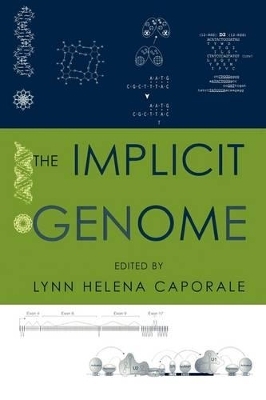
The Implicit Genome
Oxford University Press Inc (Verlag)
978-0-19-517271-3 (ISBN)
For over half a century, we have been in the thrall of the double-helicaln structure of DNA, which, in an instant, revealed that information can be transferred between generations by a simple rule, A pairs with T, G pairs with C. In its beautiful simplicity, this structure, along with the table of codons worked out in the following decade, had entranced us into believing that we can fully understand the information content of a DNA sequence, simply by treating it as text that is read in a linear fashion. While we have learned much based on this assumption, there is much we have missed. Far from a passive tape running through a reader, genomes contain information that appears in new forms which create regions with distinct behavior. Some are "gene rich", some mobile, some full of repeats and duplications, some sticking together across long evolutionary distances, some readily breaking apart in tumor cells. Even protein-coding regions can carry additional information, taking advantage of the flexible coding options provided by the degeneracy of the genetic code. The chapters in this volume touch on one or more of three interconnected themes: information can be implied, rather than explicit, in a genome; information can lead to focused and/or regulated changes in nucleotide sequences; information that affects the probability of distinct classes of mutation has implications for evolutionary theory.
Dr. Lynn Helena Caporale received her Ph.D. in Molecular Biology from the University of California at Berkeley and is the author of Darwin and the Genome. She is the Associate Director for Comparative Genomics at the Judith P. Sulzberger Genome Center at Columbia University.
Lynn Helena Caporale: An Overview of the Implicit Genome
1: Donald M. Crothers: Sequence-Dependent Properties of DNA and Their Role in Function
2: Errol C. Friedberg: Mutation as a Phenotype
3: Christopher D. Bayliss and E. Richard Moxon: Repeats and Variation in Pathogen Selection
4: David G. King, Edward N. Trifonov, Yechezkel Kashi: 4. Tuning Knobs in the Genome: Evolution of Simple Sequence Repeats by Indirect Selection
5: J. Dave Barry: Implicit Information in Eukaryotic Pathogens as the Basis of Antigenic Variation
6: Eduardo P. C. Rocha: The Role of Repeat Sequences in Bacterial Genetic Adaptation to Stress
7: Gary Myers, Ian Paulsen, and Claire Fraser: The Role of Mobile DNA in the Evolution of Prokaryotic Genomes
8: Susan R. Wessler: Eukaryotic Transposable Elements: Teaching Old Genomes New Tricks
9: Ellen Hsu: Immunoglobulin Recombination Signal Sequences: Somatic and Evolutionary Functions
10: Rupert Beale and Dagmer Iber: Somatic Evolution and Antibody Genes
11: Nancy Maizels: Regulated and Unregulated Recombination of G-rich Genomic Regions
12: Rhona H. Borts and David T. Kirkpatrick: The Role of the Genome in the Initiation of Meiotic Recombination
13: Carolyn L. Jahn: Nuclear Duality and the Genesis of Unusual Genomes in Ciliated Protozoa
14: Harold C. Smith: Editing Informational Content of Expressed DNA Sequences and Their Transcripts
15: Brenton R. Graveley: Alternative Splicing: One Gene, Many Products
16: Alyson Ashe and Emma Whitelaw: Imprinting: the Hidden Genome
John Doyle, Marie Csete, and Lynn Caporale: Epilogue: An Engineering Perspective: The Implicit Protocols
References
| Erscheint lt. Verlag | 23.2.2006 |
|---|---|
| Zusatzinfo | 80 line drawings |
| Verlagsort | New York |
| Sprache | englisch |
| Maße | 234 x 155 mm |
| Gewicht | 576 g |
| Themenwelt | Informatik ► Weitere Themen ► Bioinformatik |
| Naturwissenschaften ► Biologie ► Genetik / Molekularbiologie | |
| ISBN-10 | 0-19-517271-X / 019517271X |
| ISBN-13 | 978-0-19-517271-3 / 9780195172713 |
| Zustand | Neuware |
| Haben Sie eine Frage zum Produkt? |
aus dem Bereich


